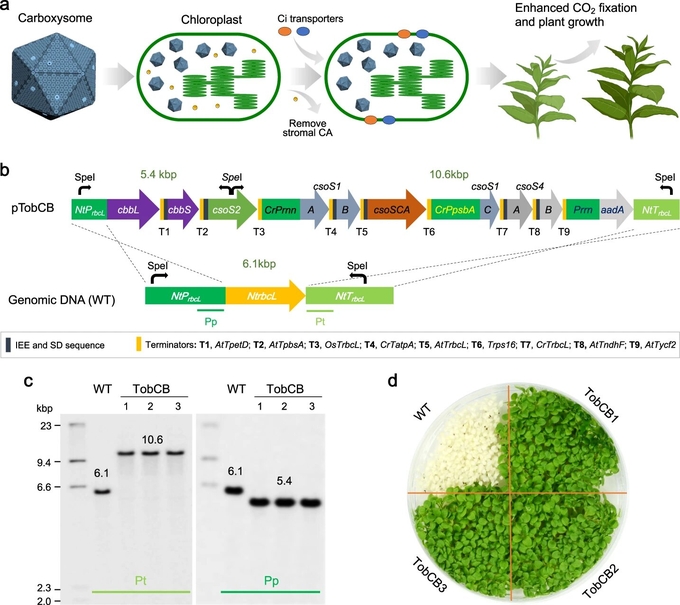May 24, 2025 | 16:24 GMT +7
May 24, 2025 | 16:24 GMT +7
Hotline: 0913.378.918
May 24, 2025 | 16:24 GMT +7
Hotline: 0913.378.918

Synthetic engineering of α-carboxysomes into tobacco chloroplasts. a Schematic representation of the strategies of introducing carboxysomes and bicarbonate transporters into plant chloroplasts and eliminating chloroplastic CA to install a complete CCM for enhanced photosynthetic carbon fixation and plant yields. b Gene organization of α-carboxysome-expressing construct for tobacco chloroplast expression and the rbcL locus in the wild-type (WT) tobacco chloroplast genome. The α-carboxysome-expressing construct contains nine genes coding Rubisco (cbbL and cbbS), the linker protein CsoS2 (csoS2), carbonic anhydrase (csoSCA), shell hexamers (CsoS1A/B/C) and pentameric proteins (csoS4A/B). The genes were grouped into three operons driven by NtPrbcL (native promoter of rbcL in Nicotiana tabacum), CrPrrn (promoter of ribosomal RNA in Chlamydomonas reinhardtii), and CrPpsbA (promoter of psbA in C. reinhardtii), respectively. The Streptomycin/Spectinomycin adenylyltransferase gene (aadA) was driven by the tobacco plastid rRNA operon promoter (Prrn)73. Intercistronic Expression Elements (IEE), SD (Shine-Dalgarno) sequence, and Terminators (T) were listed. At, Os, and Cr indicate Arabidopsis thaliana, Oryza sativa, and C. reinhardtii, respectively. c, d Southern blot analysis (c) and seed germination (d) verified the successful transgene integration and homoplasmy of the three transplastomic plants obtained. The genomic DNA was digested by SpeI and hybridized with Digoxygenin-labeled probes of the promoter (Pp) and terminator (Pt) of rbcL in N. tabacum as indicated in (b). Seed germination was performed on Murashige and Skoog (MS) medium containing 500 mg L–1 spectinomycin. Source data are provided as a Source Data file. Credit: Nature Communications (2023). DOI: 10.1038/s41467-023-37490-0
With global levels of carbon dioxide (CO2) rising and the population set to reach almost 10 billion by 2050, Professor Luning Liu's team of researchers used synthetic biology and plant engineering techniques to improve photosynthesis, creating a template that can be used on a mass scale.
Photosynthesis is the process by which plants use atmospheric CO2 to create nutrients, which are crucial for growth and the global ecosystem. The newly published paper details how the team of scientists have improved Rubisco, a key enzyme present in photosynthesis that converts CO2 into energy. Usually Rubisco is inefficient and limits photosynthesis in major crops. However, many microorganisms including bacteria have evolved efficient systems, named "CO2-concentrating mechanisms," to improve Rubisco.
Inspired by nature, the team has successfully engineered a catalytically faster Rubisco taken from bacteria, into tobacco plant cells that undertake photosynthesis to support plant growth. The new method improves the Rubisco's stability and ability to convert CO2 into energy, allowing plants to further thrive. The changes to the enzyme also potentially increase the plants ability to absorb CO2, helping to support the global effort to address climate change.
Professor Luning Liu, Department of Biochemistry and Systems Biology, University of Liverpool said, "We are extremely excited with this breakthrough. Overall, our findings provide proof-of-concept for a route to improving crop development and production that can withstand changing climates and meet the growing food requirements of the world's expanding population."
This latest study follows the team's recent attempt to engineer the faster Rubisco from bacteria to support plant growth.
(Phys.org)

(VAN) Alt Carbon has raised $12 million in a seed round as it plans to scale its carbon dioxide removal work in the South Asian nation.

(VAN) Attempts to bring down the price of the Japanese staple have had little effect amid a cost-of-living crisis.

(VAN) Fourth most important food crop in peril as Latin America and Caribbean suffer from slow-onset climate disaster.

(VAN) Shifting market dynamics and the noise around new legislation has propelled Trouw Nutrition’s research around early life nutrition in poultry. Today, it continues to be a key area of research.

(VAN) India is concerned about its food security and the livelihoods of its farmers if more US food imports are allowed.

(VAN) FAO's Director-General emphasises the need to work together to transform agrifood systems.

(VAN) Europe is facing its worst outbreak of foot-and-mouth since the start of the century.